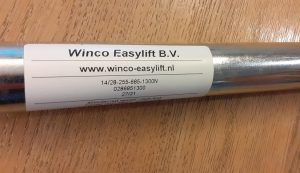Call Us: +0031 (0)541-520044
Email:
info@winco-easylift.nl
Your Company Address
Zutphenstraat 69, 7575 EC Oldenzaal, The Netherlands
Call Us: +0031 (0)541-520044
Email:
info@winco-easylift.nl
Your Company Address
Zutphenstraat 69, 7575 EC Oldenzaal, The Netherlands
Grade 316 is a typical stainless steel alloy with a melting range of 2,500 degrees Fahrenheit to 2,550 degrees Fahrenheit (1,371 degrees Celsius to 1,399 degrees Celsius). It has great strength, corrosion resistance, and high chromium and nickel concentrations as an austenitic alloy. The alloy has a maximum use temperature of roughly 800°C (1,472°F) and a tensile strength of 579 MPa (84 ksi). In addition, molybdenum has been added to grade 316, which improves the alloy’s resistance to acids, alkalis, and chloride pitting.
 In terms of commonality, 316 stainless steel is a close second to 304 stainless steel. With nearly identical physical and mechanical qualities to grade 304, distinguishing the two with the naked eye is nearly impossible. The material composition of grade 316 is the key differentiator:
In terms of commonality, 316 stainless steel is a close second to 304 stainless steel. With nearly identical physical and mechanical qualities to grade 304, distinguishing the two with the naked eye is nearly impossible. The material composition of grade 316 is the key differentiator:
Grade 316 is slightly more expensive per ounce of material than grade 304 due to the higher nickel content and the addition of molybdenum. The improved corrosion resistance of grade 316 stainless steel, notably against chlorides and chlorinated solutions, is where it shines. As a result, grade 316 particles are formed.
Some of the more common applications for grade 316 steel are:
Grade 304 stainless steel, another common high-performance alloy, is a long-lasting material with good tensile strength, corrosion resistance, and oxidation resistance. The melting point of stainless steel 304 is between 2,550 and 2,650 degrees Fahrenheit (1399 and 1454 degrees Celsius). Grade 304, on the other hand, loses tensile strength as it approaches its melting point.
Grade 304 is notable for its high tensile strength of around 621 MPa (90 ksi). The maximum operating temperature of 304 alloy is around 870 degrees Celsius.
Due to its high chromium content, 304 steel is one of the most often used steel grades. It has exceptional corrosion resistance. Its chemical make-up is as follows:
Carbon and manganese are occasionally present in modest concentrations. These components make it oxidation resistant, making cleaning and sanitization a breeze.
Some of the more common applications for grade 304 steel are:
Due to exposure to high chloride solutions or saline conditions, 304 stainless steel is susceptible to pitting, localized pockets of corrosion. Pitting corrosion can start with as little as 25 ppm of chlorides.
Grade 316 is more corrosion resistant than related alloys, such as 304 stainless steel, due to the addition of molybdenum. This decreases pitting caused by chemical conditions, allowing grade 316 stainless steel to be used in highly acidic and caustic settings where it would otherwise corrode. Grade 316, for example, can survive caustic solutions and corrosive applications like vapor degreasing and a variety of other parts cleaning operations.
Grade 316 is also suited for pharmaceutical and medical applications due to its characteristics. Because these industries’ sterilizing techniques combine both strong disinfectants and powerful disinfectants,
Metals are extremely vulnerable to seawater and salt air. Chlorides, such as salt, may eat away at even the strongest metals, in addition to the harsh environment of the sea and marine applications. The protective oxide coating of grade 304 stainless steel will be compromised by salt, resulting in rust. Grade 316 is appropriate for maritime applications or operations involving chlorides.
Grade 316 has especially better resistance to salt and chloride pitting. When stainless steel alloys, such as grade 304, come into contact with salt-rich sea breezes and seawater, pitting corrosion can occur. For marine applications or anything involving chloride, corrosion-resistant metals, such as grade 16 stainless steel, are required.
Grade 316 is robust and adaptable, making it suitable for custom wire baskets that will last for years. This stainless steel grade can be utilized to manufacture tough baskets that can withstand repeated exposure to high-impact operations. Marlin Steel’s staff, for example, creates specialized baskets for intensive parts cleaning operations and shot blasting components made of grade 316 stainless steel.
